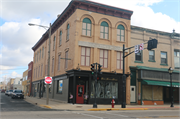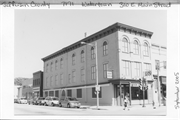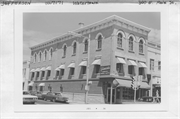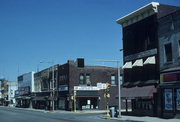Property Record
300 E MAIN ST
Architecture and History Inventory
| Historic Name: | Central Block; Weltburger; Farmers and Citizen's Bank |
|---|---|
| Other Name: | Himrich's Cards & Gifts; Mallach's Book Store |
| Contributing: | Yes |
| Reference Number: | 7171 |
| Location (Address): | 300 E MAIN ST |
|---|---|
| County: | Jefferson |
| City: | Watertown |
| Township/Village: | |
| Unincorporated Community: | |
| Town: | |
| Range: | |
| Direction: | |
| Section: | |
| Quarter Section: | |
| Quarter/Quarter Section: |
| Year Built: | 1856 |
|---|---|
| Additions: | |
| Survey Date: | 20052020 |
| Historic Use: | retail building |
| Architectural Style: | Italianate |
| Structural System: | |
| Wall Material: | Brick |
| Architect: | |
| Other Buildings On Site: | |
| Demolished?: | No |
| Demolished Date: |
| National/State Register Listing Name: | Main Street Commercial Historic District |
|---|---|
| National Register Listing Date: | 6/2/1989 |
| National Register Multiple Property Name: |
| Additional Information: | Previously surveyed in 1986. This building was known as the Central Block. It housed a number of different businesses in the nineteenth century and early twentieth century. Among the businesses housed there in 1866 was the Watertown Weltburger, one of the many locations of this newspaper throughout the years. The Weltburger was founded in the 1850s and emerged by 1860 as the dominant German-language voice of the Watertown German community. Under the editorship of David Blumenfeld, the Weltburger was a lively and successful part of the German immigrant life in Watertown. In 1912, the Central Block became the location of the Farmers and Citizens Bank. The Farmers and Citizens Bank only operated until 1956, when the Bank of Watertown assumed its assets. This building is significant for local history under National Register criterion A because it was the early location of the Watertown Weltburger, and the location of the Farmers and Citizens Bank. This is the first recorded location of the Weltburger. After two German newspapers were founded in the 1850s, they merged and became known as the Weltburger. This newspaper helped form German public opinion until the 1930s, but it was the time between the 1850s and 1905, when David Blumenfeld was editor, that the newspaper became most influential in the community. Because it was the most significant German language newspaper in a community of Germans, the Weltburger is an important institution in the area of German ethnic settlement institutions. The Weltburger was located at a number of places in the downtown. This is its first recorded location and may have been THE first office. By 1872, it had moved to Second St., and it is unclear how long it was here. But, as the first known location of the paper, this building has significance. The building is also significant as the location of the Farmers and Citizens Bank, a twentieth century bank that tried to make Watertown a four bank community, but in the mid-twentieth century failed. The bank was never prominent enough to build its own building, so this structure has significance as the location of this bank which helped broaden the financial services of the community in the twentieth century. A large, cream brick, three-story, three-bay building topped by a broad projecting, wooden, bracketed Italianate cornice, the Central Block was built in 1856 for the Keck and Lehmann Furniture Shop and Store. Round arches resting on capped, two-story, applied brick pilasters form an arcade across the facade and the west elevation. Round arched windows are located on the recessed bays of the arcade on the third floor while rectangular windows with triangular pediment shaped window heads are located on the second story. The Central Block has been altered by the addition of fake stone and horizontal siding on the first story of the west elevation as well as the storefront on the facade. The majority of the windows have been filled in with a wood panel. Also the storefront featuring a recessed corner entrance has been remodeled in a contemporary manner. Although the Central Block was a good example of a vernacular commercial building influenced by the Romanesque Revival and Italianate style, the alteration of the street level facade, storefront and of the windows has diminished its architectural significance. However, the Central Block contributes to the historic architectural character of the Main Street commercial historic district. The Central Block should be re-evaluated if it undergoes rehabilitation or restoration. |
|---|---|
| Bibliographic References: | (A) Watertown City Directories, 1866-1930, Watertown Public Library. (B) "Der Weltburger" German Newspaper, Was Printed in Watertown for 80 Years," Watertown Daily Times Centennial Issue June 26, 1954. (C) John H. Ott, ed., Jefferson County Wisconsin and Its People, Chicago: S.J. Clarke Publishing Co., 1917, p. 247. (D) Building Inscription. (E) Watertown Democrat May 22, 1856. (F) Tax Records, City of Watertown, 1855-1860, Area Research Center, Library, University of Wisconsin-Whitewater. (G) C. Hugo Jacobi, "Reminiscences of Early Days in Watertown," Watertown Daily Times Feb. 11, 1924. |
| Wisconsin Architecture and History Inventory, State Historic Preservation Office, Wisconsin Historical Society, Madison, Wisconsin |





